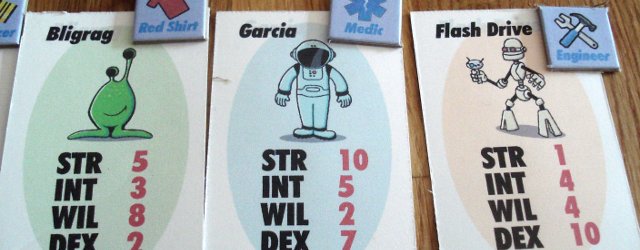| Strategy | Luck |
|---|---|
| Interaction | Components & Design |
| Complexity | Score |
Our copy of Final Frontier was kindly supplied by Victory Point Games.
– Captain, we have encountered some sort of energy field.
– Another one? Alright, here’s what we do: Zeeb, you think of a solution how to get out of the energy field, then before you tell us about it, you hit your head on the console and pass out.
– Very well, Captain. This energy field is very similar to one that is in our databases, so to escape we should simply *BONK*
– Perfect. Now, Tororo, you take care of him for the next 40 minutes, then you wake him up so he can resolve the crisis, in the meantime we’ll struggle to communicate with the Frabnoz ship that is also trapped here and might be hostile.
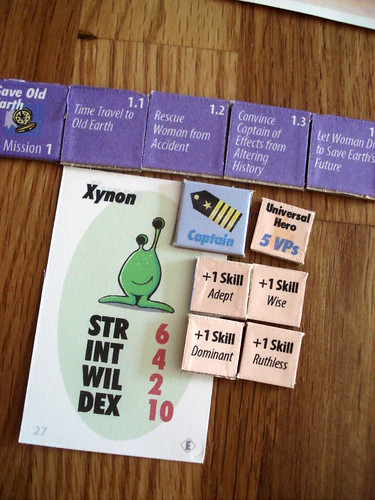
Final Frontier is a game that is not afraid to flaunt its origin. If the title isn’t enough to convince you that this is a game based on the most famous science fiction series ever made then just consider this: the designated victim to go on dangerous away missions with you is called the Red Shirt. There’s really nothing else to add, is there? And just like in that famous series, your crew zooms around the galaxy to complete missions, escape interstellar disasters, meet alien species – and sometimes kill them.
Each players crew is a collection of seven cards. You may use the premade decks, but we usually used the draft rules described in the rules, just because it’s satisfying to pass on the most incompetent people to your opponents. What makes a crew member incompetent or not are four attributes: Strength, Intelligence, Will and Dexterity. To Captain James Tiberius Kirk’s great dismay Sex Appeal Towards Aliens did not make it on the cards. Each attribute has a value from 1 (Spock’s Empathy rating) to 10 (his Logic). When you gathered your crew of seven, you assign their roles: Captain, 1st Officer, Engineer, Medic, Red Shirt and two Ensigns who are basically useless but can be promoted after the tragic yet inevitable death of another crew member.
When you’re done picking your victims crew, it’s time to boldly go where no man has gone before. But the universe is a big place and the Hitchhiker’s Guide has not been published yet, so the central question each round is where to go. Picking a mission is a cooperative effort if you understand cooperative to mean “we all do it together, but our goal is to mess with the others”. A mission is defined by four parameters: its destination (planetary or deep space), purpose (exploratory or hostile), how many crew members are allowed to go (one or two) and which of your officers will lead the mission (the Red Shirt is not considered an officer for this purpose, his official designation is Dead Man Walking). Each combination of destination and purpose has a different hierarchy of attributes that may be relevant: hostile deep space missions, for instance, are most likely to test your crew’s Intellect, somewhat less likely to test their Strength and will only rarely test your Will. Each player, in turn, decides one of the four aspects, trying to arrange for a mission that will suit his crew’s strengths. If the mission is for one crew member only then that was all the choices you could make – only the selected leader will go on the mission. If he can choose a trusted companion to be at his side, then you still get to decide who it should be before beaming down. Or up. Or wherever.
– We’re detecting strong tectonic activity from the planet. A volcanic eruption is imminent with a 99.97% certainty. Thousands of natives will die.
– Our First Priority dictates that we may not interfere. But we cannot let these people die. An away team will disguise as natives and lead the evacuation with logistic support from up here. Lieutenant Camisaroja, take Corporal Rothhemd and Ensign Hong Chenshan and beam down at once.
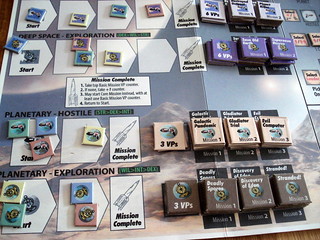
Only after you chose the crew members to go is the challenge revealed, including classics like negotiating with space pirates or defeating your evil mirror universe alter ego. The flavour text is fun, but overcoming the challenge boils down to cold, hard numbers. Spock approves. Each challenge names one attribute and a value that you have to surpass. In most cases your crew members will not quite hit that number, and then comes the hardest decision of the game: does one of your heroes advance backwards screaming like a little girl to be replaced by the Designated Victim Red Shirt before you try your luck with the dice? Because if you fail … someone might die! You have two chances to roll the dice: if you miss the target number with the first, you won’t complete the challenge but you can still save your people. If the second roll doesn’t fix it, then someone dies. You’ll have to promote one of your Ensigns to the new vacancy, and when you run out of Ensigns the seat is filled by a civilian, easily recognized by his total lack of a) uniform and b) useful attribute scores. Needless to say you do not, under any circumstances, want to have civilians on your missions.
In the unlikely case that you survive the mission you advance your marker on the mission track and, when you reach the end, take one of the Mission Complete markers from that track. Additionally, if your score was the highest for that challenge, you receive a +1 Marker that you can either use as a victory point or place on a character card to increase all its attributes by one. After eight challenge cards have been resolved like that the game is over and … you just graduated from the Academy. Because all this is the basic game, the Five Year Mission has some more things to take care of. I recommend you play the Academy Training at least once before you graduate to the full game, not because it makes the game so much harder but because I found it very difficult to piece together the rules for it without completely setting up the Training game once – and then you might as well play it, right?
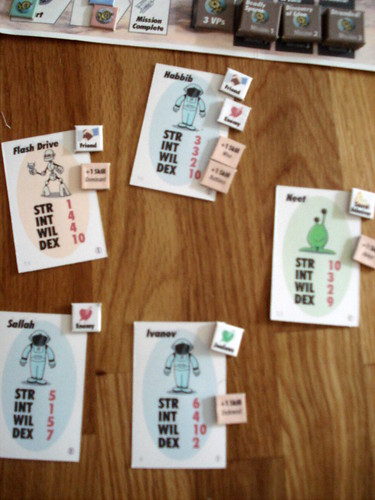
The Five Year Mission is not only longer – 24 challenges – but also adds the more complex Core Missions to the mix. After you complete the basic mission track you may, instead of taking the mission complete marker and the points that come with it, embark on a Core Mission of that mission type. Each core mission has three challenges that you must overcome; you may try to do so every time the mission selected is of the same type as your Core Mission. These challenges are a bit tougher than the basic challenges, but their reward in victory points is significant.
The second new feature are the special event cards, shuffled into the challenge deck. Some of those go to your hand to be used later in the game with powerful but not especially interesting effects. The fun ones are the relationship cards: they might turn two members of someones crew into mortal enemies who can never go on a mission together. Or they might become BFFs, completely unable to go on a mission without the other. And there’s still Secret Admirers and Jealous crew members to mess with things more. These effects are fun and can really, really mess up someone’s game. But they are also very unbalanced because they do really, really mess up someone’s game, so badly that having two of the four used against you makes it almost impossible to win.
Finally, the Five Year Mission has some other ways to gain victory points: having the first crew member with three +1 markers on his card makes him the Universal Hero and brings you five points. Similarly, surviving failed missions, completing missions with the same partner or completing missions as a civilian awards bonus points. These bonuses are a pretty nice balancing measure to the Core Missions: if your crew just blows too much to complete those, then collecting bonus markers from basic missions can sometimes be enough to still win the game.
Unfortunately, something else in Final Frontier needed balancing much more urgently: crew member death. I know that the point of the game is to manage your luck and send the Red Shirt on suicide missions instead of your more valuable officers – but completing only the safe challenges doesn’t get you anywhere, either, you have to take some risks. And taking some risks can make you run out of Ensigns very quickly, and then you’re lost in space. What the game really needed was an option to repopulate your ship. Return to the Academy, lose a turn, recruit new crew members, something like that. Because as it is, once you’re out you’re really out, and you won’t be coming back. If that happens due to bad decisions, fine, that’s part of the game. But if it happens because you roll two ones on a challenge where you “only” needed a three to succeed it’s frustrating. And not frustrating like falling down in a game of Can’t Stop that will be over in ten minutes with everyone falling down: you might be spending the better part of an hour playing in absolute certainty that you cannot win. Add the big negative impact of the relationship cards and we had one test player that couldn’t be convinced to try a second Five Year Mission without some house rules.
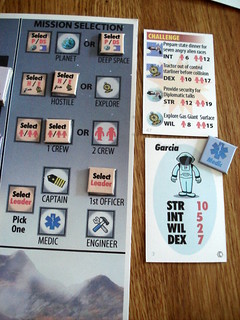
I do like the mission selection mechanic in Final Frontier, chosing one aspect of the mission at a time to try and screw the others over is fun, and while the first player to decide on a mission parameter is at a disadvantage the changing start player puts everyone into that particular pickle sometimes. The game could have done with some more player interaction outside of the mission selection, but it’s not as solitaire-y as some other games we played recently. Finally, I don’t want to talk too much about the components of Final Frontier. If you know Victory Point Games then you know that their games are produced with simple components and to be easily portable. I like good illustrations and of course I especially like meeples, but I won’t hold the lack of either against the game in general – only against its Component score. One thing about the components, however, could be improved: the cards, printed on standard rough cardstock, are very hard to shuffle and deal.
But the components are really not my main issue with Final Frontier – that a player can basically be eliminated from the game without actually being allowed to leave the table is. I understand it’s a risk management game, but the punishment is too harsh for a game with this much luck.
– Zeeb! So good of you to finally join us. What can you tell me about this energy field that is still holding us?
– Thank you for inquiring, Captain, I am feeling quite well. This energy field is easy to disrupt, we just have to reverse the polarity in the Tripolamin Collator and emit a focused Blarium impulse aimed at the magnetic center of the field …
– Zeeb, how often do I have to tell you to drop the techno babble?
– *sigh* Just press the green button on your armrest, Captain.
– See, that wasn’t so hard. Set course to wherever and take us away. And now, if you’ll excuse me, I have someone with green skin waiting in my quarters, if you know what I mean.

